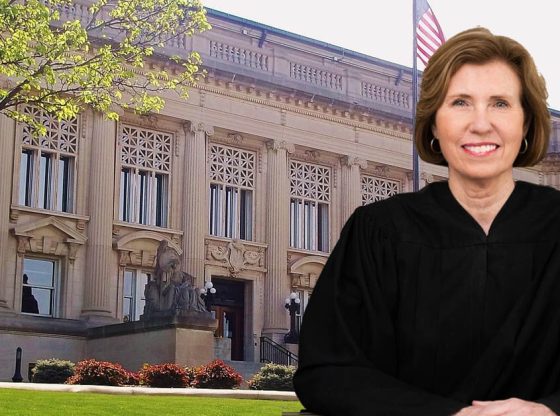
When Justice Elizabeth Rochford was elected to the Illinois Supreme Court in November 2022, she joined the most diverse Court in Illinois history. This included a historic majority of five female Justices and three Black Justices.
Throughout her career, Justice Rochford has been deeply committed to issues surrounding women and the law. Her focus has spanned from ensuring access to justice for women through the court system to supporting opportunities for women to cultivate long-term and meaningful careers in the legal profession.
Justice Rochford has been active in the Illinois State Bar Association’s (ISBA) Standing Committee on Women and the Law, which focuses on areas of law uniquely affecting women, and has received the ISBA’s Woman of Influence Award, the Illinois Judges’ Association’s Presidential Service Award, the Lake County Bar Association’s (LCBA) Access to Justice Award, the Outstanding Diversity Leader Award from the Diversity Scholarship Foundation, and the LCBA Leadership Service Award, among others.
Justice Rochford was appointed Supreme Court Liaison to the Commission on Professionalism in 2023.
We had the opportunity to speak to Justice Rochford about the challenges women face in the legal profession, the significance of serving as part of the Court’s historic female majority, and why she is optimistic about the future of women in law.
1. Throughout your career, you have worked to raise awareness of the unmet legal needs of women. What unique challenges do women face in accessing the justice system?
I have long been committed to advancing the Illinois Supreme Court’s mandate to provide access to justice for all people, especially the poor and the vulnerable.
Both statistics and observation reveal that women comprise a significant portion of the disadvantaged populations that the Supreme Court had identified as having less access in law. The unique challenges women face include, but are not limited to, gender discrimination, lack of knowledge about their rights, social stigmas, economic and educational disadvantages, domestic violence, and time demands.
Although we are well-intentioned in our efforts to achieve parity for women, sometimes we miss the mark because we are unaware of the actual needs of the community.
To best appreciate the challenges faced by women, and other populations with reduced access, it is essential that we step out of the boundaries of the courthouse and into the communities we seek to serve in order to engage with them, identify their true needs, and respond with meaningful solutions.
2. You are a strong advocate for women in the legal profession. What are the biggest hurdles women face in achieving gender equity within the profession?
In law, women are significantly represented at junior levels, though with a dramatic reduction in representation at senior levels, and the gender pay gap is still very real. But progress is being made. Childbearing and raising are less frequently viewed as disqualifying, but rather as advantages of life experience and relatability. Increased remote work opportunities provide ever more flexibility in the workplace.
I am extremely optimistic for the future of women in law. Women are ready to lead the way, and not just on their own behalf, but for all people who have been historically marginalized. Women have a growing power base and a unique opportunity to speak up and open minds on human and professional inequities across the board including race, sexual identity, social circumstances, religious affiliation, ethnicity, income, and gender! I envision a bright future for our profession.
3. How have things changed for women attorneys and judges since you started practicing law?
Women are present in our profession in far greater numbers than when I began to practice. But the most exciting change I have witnessed is that women are organizing, both formally and informally, to offer each other encouragement and support. Women are making referrals, sharing meaningful navigation tools, serving as mentors to female colleagues, and the positive impact is immeasurable.
4. Five women now serve on the Illinois Supreme Court. How do you feel being part of such a historic majority?
Our Illinois Supreme Court looks very different than it has at any other time in the past. We have a female majority of five women, and three Black justices, both historic achievements.
The visual of our Court creates a powerful image, and Illinoisans should be proud. We know that a diverse bench is vital to achieving a fair system of justice, and in promoting public trust. But in truth, the work of this Court will not be persuaded by alliances of gender, race, ethnicity, or politics, but rather a measured and competent commitment to follow the rule of law, the same established methods of dispute resolution on which our predecessors confidently relied.
Although much of our work is properly steeped in tradition and adherence to precedent, there is also always room for improvement.
Our Chief Justice Mary Jane Theis has taken an open-minded and progressive approach to this Court’s administration. She encourages suggestions and discussion about better procedures, in favor of reliance on merely the way things have always been done.
5. Could you share some female role models who inspire you in the legal profession and beyond?
So many magnificent women have paved my path and inspired me, but no one more than my mother “LuLu,” who was a model of intelligence, grace, and kindness.
In the legal profession, I have long admired and relied on the standard established by women like trail-blazing attorney Alice Kolnick, my cousin and model of integrity Justice Mary Kay Rochford, and my judicial mentor and visionary, Judge Margaret Mullen.

